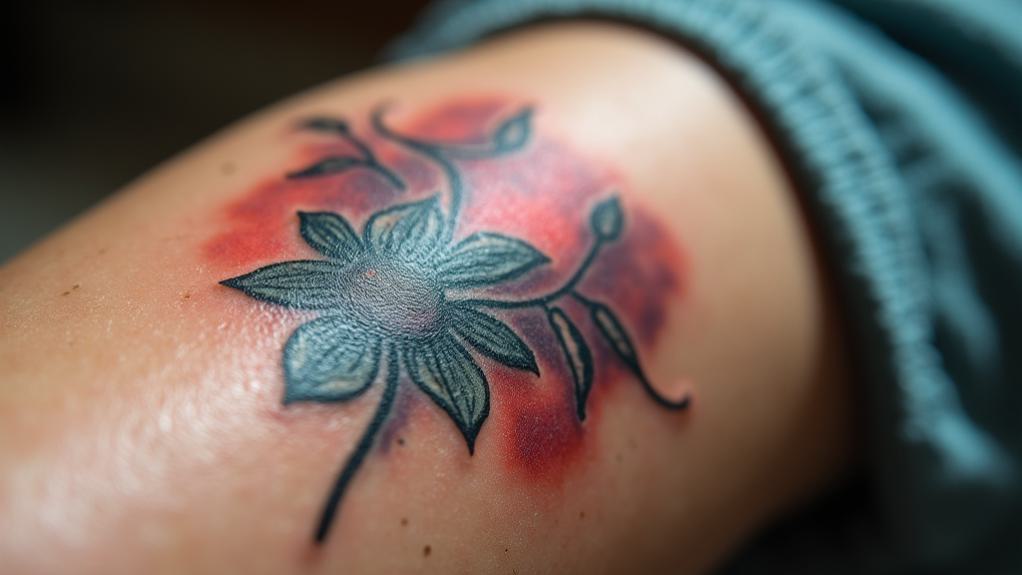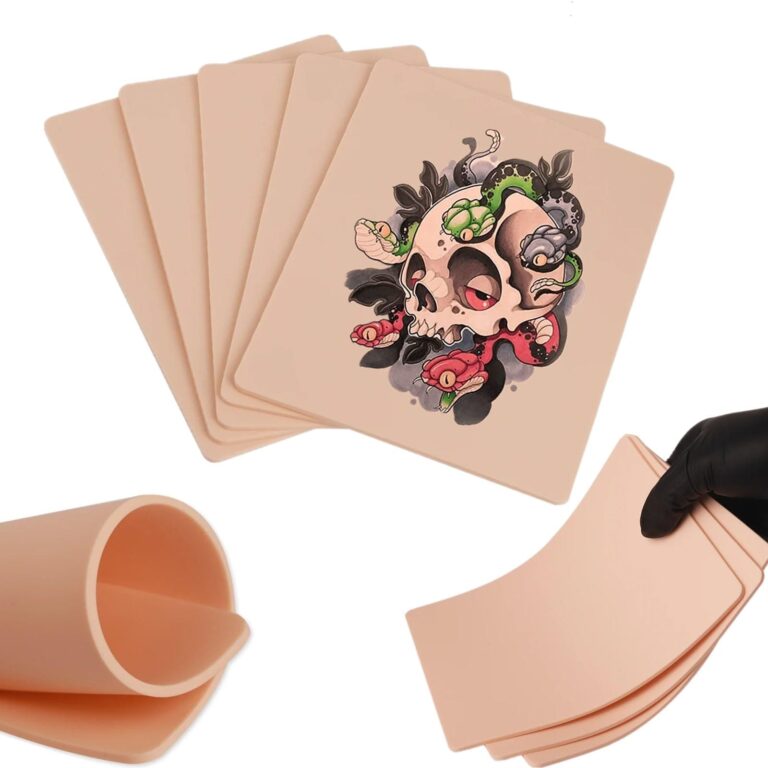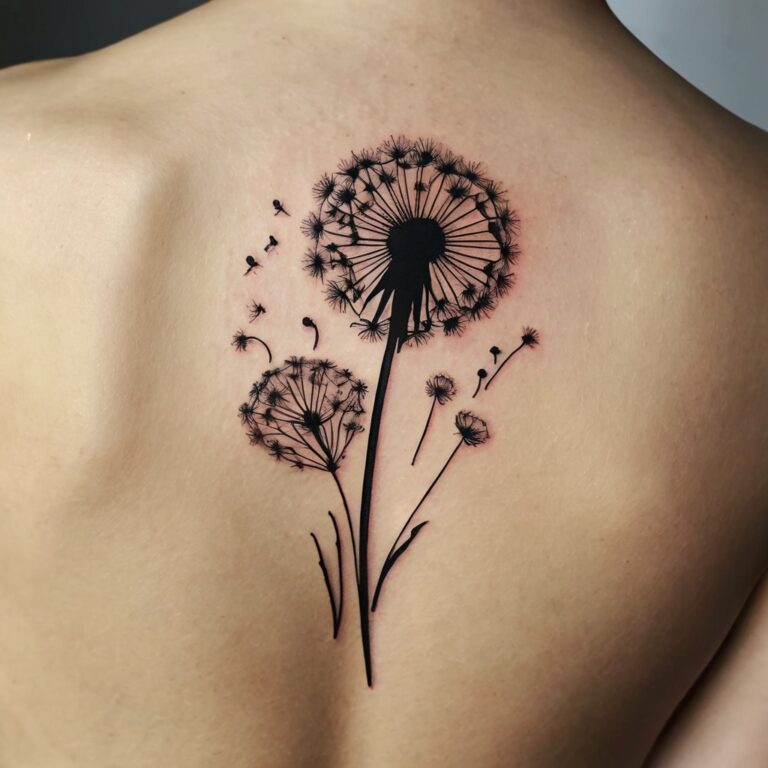A tattoo is a form of body art created by inserting ink into the skin to form designs or images. If you've noticed your tattoo looking a bit faded, you're not alone—this is a common concern among tattoo enthusiasts.
There are several factors that can contribute to tattoo fading, including sun exposure, the type of ink used, and even individual skin type and age.
To address the question, "Why does my tattoo look faded?" the fading can be attributed to these various influences, and understanding them is crucial for maintaining your tattoo's appearance over time.
In this post, we will explore the key factors that lead to fading and provide effective strategies to keep your tattoo looking fresh and vibrant.
Common Causes of Fading
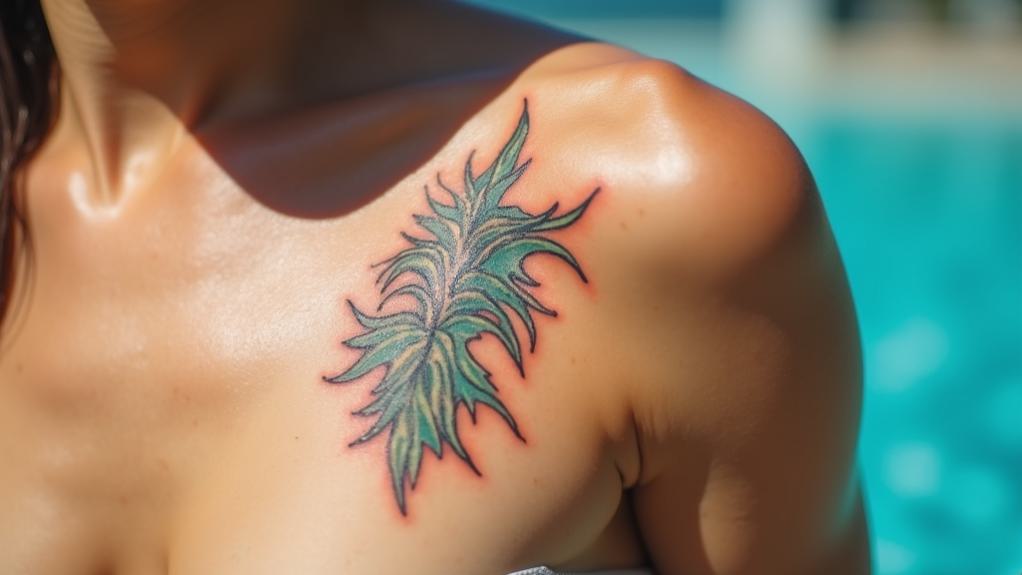
Tattoo fading may occur due to several factors, and understanding them can help maintain the vibrancy of your ink.
Sun exposure is a primary cause; UV rays may break down the pigments in your tattoo, leading to a loss of intensity. Therefore, applying sunscreen on your tattoo before heading outdoors is crucial.
The location of your tattoo may also affect its longevity. Tattoos on areas of the body that experience more friction, such as the elbows or knees, may fade faster due to the natural shedding of skin cells and movement in those areas.
Additionally, your skin type may influence how your tattoo appears over time. Oily skin may cause the ink to spread, resulting in a softer look, while dry skin may lead to flaking, which could dull the tattoo's appearance.
Types of Tattoo Ink
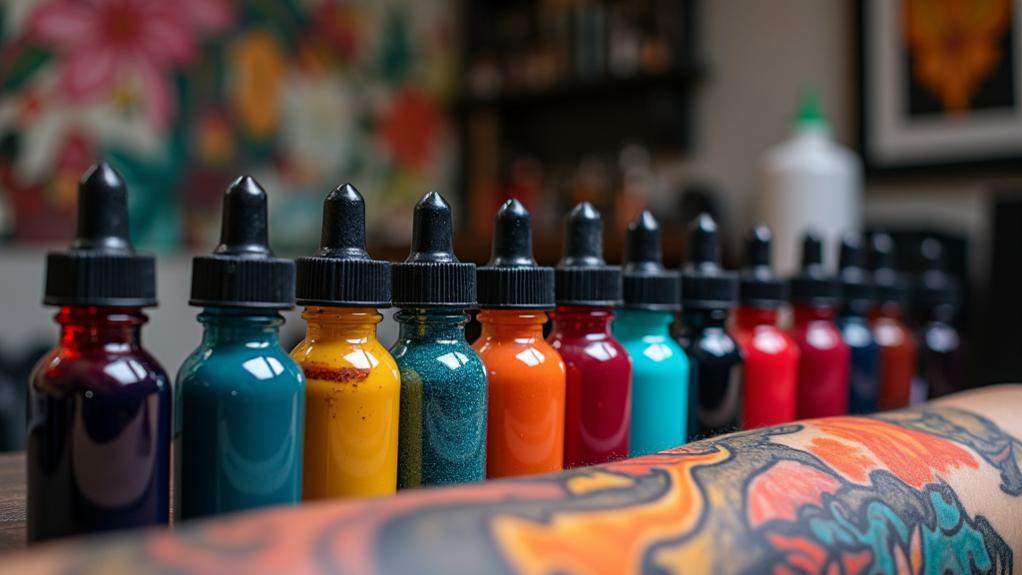
When you choose a tattoo ink, you're really considering its composition and how it'll react over time.
Different colors and qualities of pigments can affect both the vibrancy and stability of your tattoo.
Understanding these factors can help you make a more informed decision for your ink.
Ink Composition Effects
The composition of tattoo ink may significantly affect how your design ages over time.
Tattoo inks are generally made from pigments suspended in a carrier solution. Organic pigments may provide more vibrant colors but may not endure UV exposure as well as inorganic pigments, which are typically more stable and less prone to fading.
The carrier solution may also influence how well the ink binds to your skin. Some inks may use water, while others may contain alcohol or glycerin, affecting the ink's healing process and the long-term appearance of the tattoo.
When selecting a tattoo artist, it's important to consider their ink selection. High-quality inks may yield better results and help preserve the integrity of your design.
Understanding ink composition may help you make informed decisions for a lasting tattoo.
Color Stability Factors
Choosing the right type of tattoo ink can significantly affect color stability over time. Inks specifically formulated for tattoos may offer better adhesion and longevity compared to craft or art inks.
Colors like black and dark blue may retain their vibrancy longer than lighter colors, which may fade more quickly. Red and yellow inks are known for being less stable and may require more frequent touch-ups.
The type of base in the ink also matters; water-based inks may fade faster than solvent-based inks, especially with sun exposure or harsh environments.
Additionally, opaque inks may provide better coverage and color retention than translucent inks, which may appear faded over time.
Always consult with your tattoo artist about the best options for your desired design.
Quality of Pigments
The quality of pigments used in tattoo ink may significantly affect how well your tattoo ages. High-quality pigments may result in more vibrant colors and greater resistance to fading compared to cheaper alternatives.
There are two main types of pigments: organic and inorganic. Organic pigments, derived from natural sources, may offer vibrant colors but may fade faster over time. In contrast, inorganic pigments, which are synthetic, may be more stable and less likely to lose their brightness as the years pass.
Additionally, the concentration of pigments in the ink may influence the tattoo's longevity; a higher concentration may lead to a more vivid and long-lasting result. The artist's technique is also crucial, as even the best ink may fade if not applied correctly.
Ultimately, investing in quality pigments and a skilled tattoo artist may significantly enhance the longevity and appearance of your tattoo.
If fading is a concern, you may want to discuss pigment options with your artist to ensure the best results for your body art.
Skin Type and Tattoo Longevity

Your skin type can greatly affect how long your tattoo lasts and how it heals.
Oily, dry, or sensitive skin each responds differently to the tattooing process, which can influence fading over time.
Understanding your skin's characteristics can help you take better care of your ink and make sure it remains vibrant longer.
Skin Type Variations
Understanding how skin type influences tattoo longevity is crucial for your tattoo experience. Here are the key effects of different skin types on tattoo longevity:
1. Oily Skin: Tattoos may appear vibrant initially, but excess oil may lead to faster fading as the ink may not settle deeply, requiring more touch-ups.
2. Dry Skin: Dry skin may absorb ink more effectively, potentially leading to longer-lasting tattoos.
However, lack of regular moisturizing may cause cracking, which can result in a faded or distorted appearance.
3. Sensitive Skin: Sensitive skin may react poorly to tattoo ink, possibly leading to irritation or allergic reactions.
This can cause the ink to fade more quickly or necessitate extra caution during the healing process.
Healing Process Impact
Healing properly may significantly impact how long your tattoo lasts, influenced by your skin type. Oily skin may lead to quicker healing, but excess oil can cause fading over time.
Conversely, dry or sensitive skin may take longer to heal, increasing the likelihood of scabbing and affecting the tattoo's appearance.
The elasticity and thickness of your skin may also affect the healing process. Thicker skin may hold ink better, resulting in a more vibrant tattoo, while thinner skin may show signs of fading sooner.
Additionally, conditions like eczema or psoriasis may complicate healing and reduce the longevity of your tattoo.
To optimize healing, it's essential to keep the tattoo clean and moisturized. Avoiding picking at scabs and sun exposure may help prevent fading.
Sun Exposure and UV Damage

Sun exposure may significantly impact the vibrancy and longevity of your tattoos. Prolonged exposure to UV rays may cause your ink to fade, and without proper precautions, your tattoo may lose its sharpness over time.
Here are three key reasons to protect your tattoo from the sun:
- UV Radiation: Ultraviolet rays from the sun may break down the pigments in your tattoo ink, leading to fading.
- Skin Damage: Sun exposure may result in skin damage, such as sunburns, which can alter the appearance of your tattoo, making it look uneven or less defined.
- Aging Effects: Chronic sun exposure may accelerate skin aging and create a leathery texture, distorting your tattoo's appearance.
To maintain your tattoo's beauty, you may want to apply a high SPF sunscreen whenever you're in the sun.
Staying in the shade or wearing protective clothing may also help preserve your ink's vibrancy.
Tattoo Aftercare Practices
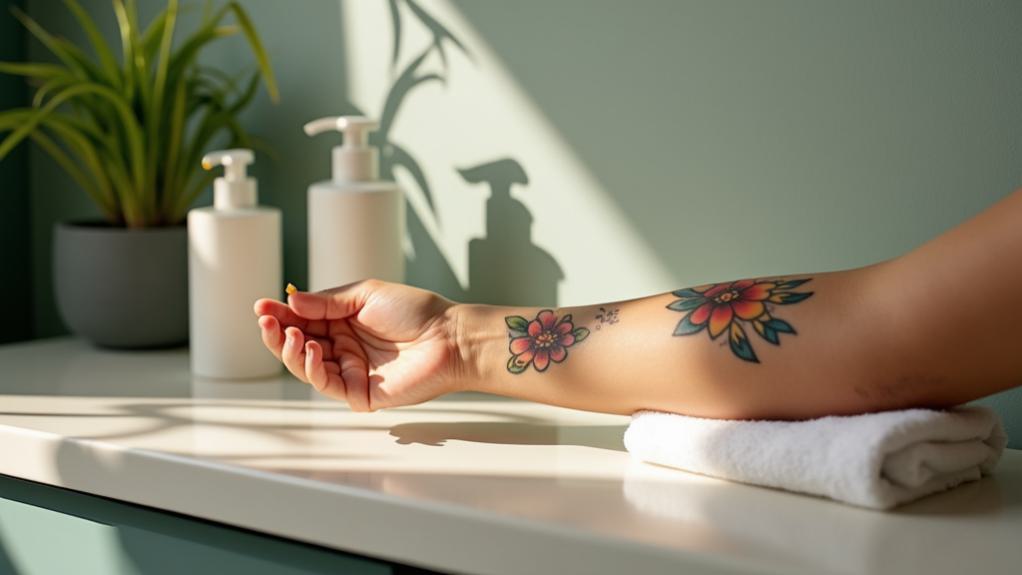
To keep your tattoo vibrant, follow these essential aftercare steps:
Clean the tattoo gently with mild soap and water, then pat it dry with a clean towel. Apply a thin layer of fragrance-free moisturizer or an ointment recommended by your tattoo artist to keep the skin hydrated and promote healing.
Avoid tight clothing over the tattoo during the healing process to prevent irritation.
For the first few weeks, soaking your tattoo in water may lead to complications, so skip baths, pools, or hot tubs; instead, take short showers. If necessary, keep the tattoo covered with a bandage.
Resist scratching or picking at any scabs, as this may cause fading or scarring.
After the initial healing period, continue to moisturize regularly and apply sunscreen when exposed to sunlight to help maintain the tattoo's vibrancy for years.
Age and Skin Changes
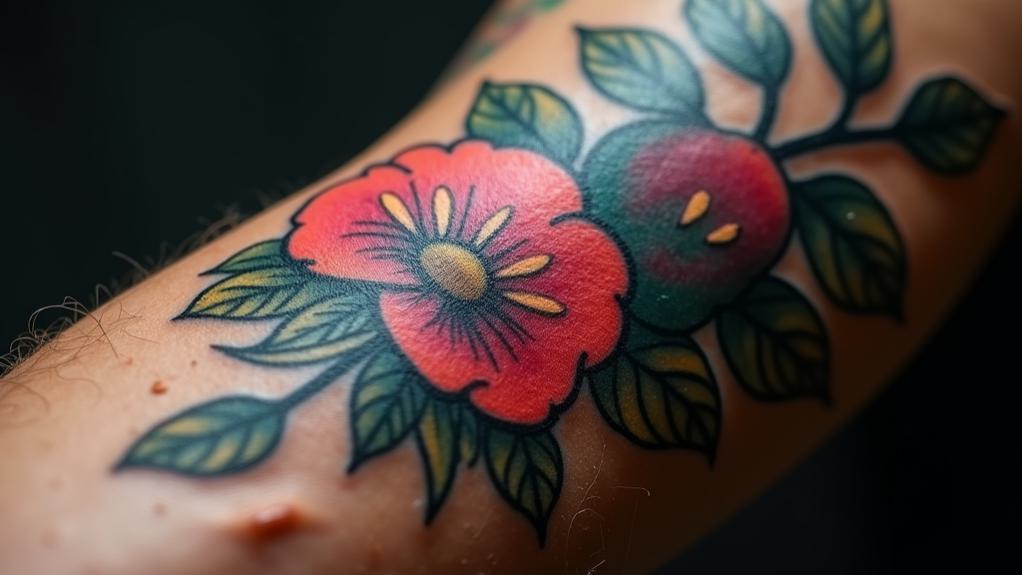
As you age, your skin may undergo changes that impact the appearance of your tattoos. Key factors include:
- Decreased Collagen: Your skin may produce less collagen as you age, resulting in thinner skin that may cause tattoos to appear more faded and less defined.
- Loss of Elasticity: Aging skin may lose elasticity, leading to potential stretching or blurring of tattoos, particularly in areas prone to sagging.
- Sun Damage: Prolonged sun exposure may cause skin discoloration, making tattoos look dull. UV rays may break down the pigments in the ink, contributing to a faded appearance.
To maintain your tattoo's vibrancy, consider regular moisturizing and sun protection.
These practices may help mitigate the effects of aging on both your skin and your tattoos.
Touch-Up Techniques
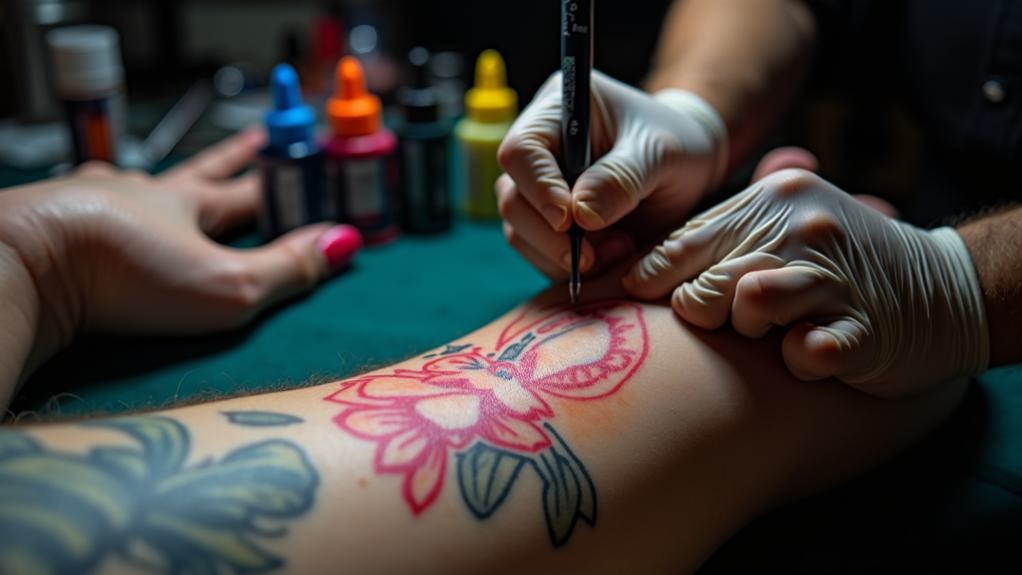
When your tattoo begins to fade, scheduling a session with your tattoo artist may be the most effective way to refresh its vibrancy. They can assess the fading and determine how to best restore the ink, often using the same colors and techniques to blend with the existing design.
If certain areas are particularly faded, a color boost may be an option, where fresh ink is applied to those spots to enhance the overall appearance without needing to redo the entire piece. Clear communication about your concerns with your artist may help them tailor their approach.
Tattoo cover-ups may also breathe new life into an old design if you're seeking a completely different look.
After a touch-up, proper aftercare is crucial. Keeping the area moisturized and protected may help maintain the vibrancy of your refreshed tattoo.
Regular touch-ups may keep your ink looking bright and beautiful for years to come.
Preventive Measures for Vibrancy

To keep your tattoo vibrant, adopt these essential preventive measures:
- Sun Protection: Apply a high-SPF sunscreen on your tattooed skin when exposed to sunlight. UV rays may fade colors quickly, making it crucial to shield your tattoo.
- Moisturize Regularly: Hydrating your skin may prevent dryness that can lead to cracking and fading of your tattoo. Use a fragrance-free moisturizer or specialized tattoo balm for best results.
- Gentle Cleansing: Use a mild, moisturizing cleanser to clean your tattoo. Harsh soaps and scrubs may cause irritation and fading, so opt for gentler options.
Frequently Asked Questions
Can Certain Medications Affect Tattoo Fading?
Yes, certain medications may affect tattoo fading.
Medications like corticosteroids or those that increase sun sensitivity may impact how your tattoo holds up over time.
These drugs may alter your skin's healing process or lead to quicker fading.
Always check with your doctor about potential side effects on your skin and tattoos.
Staying informed may help you keep your ink looking vibrant for longer.
How Often Should Tattoos Be Touched Up?
Tattoos may need to be touched up every few years, especially if you notice significant fading or changes in color.
Factors like sun exposure, skin type, and ink quality may impact how often you need a touch-up.
If you see your tattoo losing its vibrancy, it may be a good idea to consult your artist.
They can assess your tattoo and recommend the best timing for a touch-up to restore its original beauty.
Do Certain Colors Fade Faster Than Others?
Yes, certain colors may fade faster than others.
Generally, brighter colors like red, yellow, and white may lose their vibrancy quicker due to their pigment composition. Dark colors, such as black or blue, may hold up better over time.
Sun exposure, skin type, and aftercare may also play significant roles in how well your tattoo retains its color.
To maintain your ink's appearance, you may consider regular touch-ups and protecting it from sun damage.
Can Lifestyle Choices Influence Tattoo Longevity?
Yes, lifestyle choices may influence your tattoo's longevity. Spending time in the sun without proper sunscreen may lead to quicker fading of your tattoo's colors.
Additionally, smoking and drinking may affect skin health, which could lead to potential fading. Staying hydrated and maintaining a healthy diet may help keep your skin vibrant, which in turn may preserve your tattoo's appearance.
Regular moisturizing and avoiding harsh chemicals are essential for keeping those inked designs looking fresh.
Is Fading More Common in Specific Body Areas?
Fading may be more common in specific body areas. Areas exposed to sunlight, like your arms and hands, may show more fading over time due to UV damage.
Additionally, spots with thinner skin, such as your inner biceps or ankles, may not hold ink as well.
If you notice fading, you may consider adjusting your skincare routine or applying sunscreen to protect those areas and maintain your tattoo's vibrancy longer.
Conclusion
In summary, keeping your tattoo vibrant requires attention to various factors. By understanding the common causes of fading and choosing quality ink, you can help guarantee your tattoo lasts. Protecting your skin from sun exposure, following proper aftercare, and being mindful of how your skin changes with age are all essential. Don't forget to take into account touch-ups and preventive measures to maintain that bold look. With the right care, your tattoo can stay as stunning as the day you got it!

